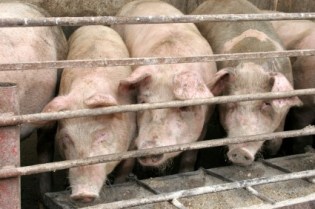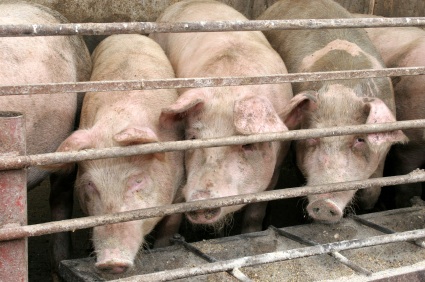
Hogs lined up at a trough on a factory farm -- behaving not unlike certain lawmakers using their power to defend their business interests.
Now that The New York Times editorial page has come out against what are now known as “Ag-gag” laws (thanks, Mark Bittman!), I think we can say this story has truly gone national. These laws, on the books in a few states already and quickly moving through legislatures in Florida, Iowa, and Minnesota, would attempt to make it illegal to produce — and in Minnesota to possess — undercover videos of livestock factory farms.
But a blogger has offered a whole new twist on this story. In Minnesota, at least, it’s not the massive factory farms that reek to high heaven. So too does the legislative process around this bill. According to Shari Danielson at Simple, Good and Tasty, several of the cosponsors of the bill in the Minnesota House and Senate are themselves farmers.
I mentioned in my post on the Minnesota law that the bill’s lead author, Rep. Rod Hamilton, is a pig farmer. But Danielson observes that he works for Christensen Family Farms, “which raises three million pigs a year, making it the third largest pork producer in the U.S.” His job? Director of communications — Christensen’s chief media spokesperson.
Two other representatives on the House side, Greg Davids and Paul Anderson, identify themselves as farmers, as does the lead coauthor of the Senate bill, Sen. Doug Magnus (a former livestock grower). One other Senate coauthor, Rod Skoe, is also a farmer (though not a livestock farmer)
I don’t think it’s an exaggeration to call this bill — at least for several of its cosponsors — self-dealing of the highest order. It’s one thing for corporate lobbyists to pressure lawmakers to pass bills that work in their clients’ favor. But in this case, these lawmakers stand to benefit directly from an Ag-gag law. By acting to put this law in place, they are protecting their own personal business interests since these undercover videos can lead to fines, lawsuits, and financial losses of various kinds. It’s been said that the worst government corruption occurs in state capitals. And these fine Minnesota legislators now stand as Exhibit A.
If I were a Minnesotan, I would be absolutely outraged. The good news is that many of the state’s citizens are. The bill appears to be generating far more heat than any of its cosponsors imagined. Indeed — and appropriately for a bill designed to decrease transparency — Danielson ran into a brick wall trying to report on it:
No one wanted to talk to me about these bills. Honestly, I approached every one of them in a non-confrontational manner, didn’t take sides, and asked them only to help me understand their reasons for introducing these bills in the Minnesota State legislature.
Christine Coughlin, president of Minnesota Voters for Animal Protection, thinks she knows why everyone was so tight-lipped.
“I think they’ve been bombarded, and frankly surprised, by the overwhelmingly negative reaction to these bills,” she told me.
She appears to be right. Minnesota’s attempt to outlaw videotaping inside animal facilities has gone over like a lead balloon. With the public. And the media. Even conservative daily newspapers in rural Minnesotan counties have come out against it.
For years, Republicans have bruited the benefits of legislators with “real” business experience, rather than “career politicians.” Instead of cleaner government, we’re getting a process, literally and figuratively, caked with manure.



